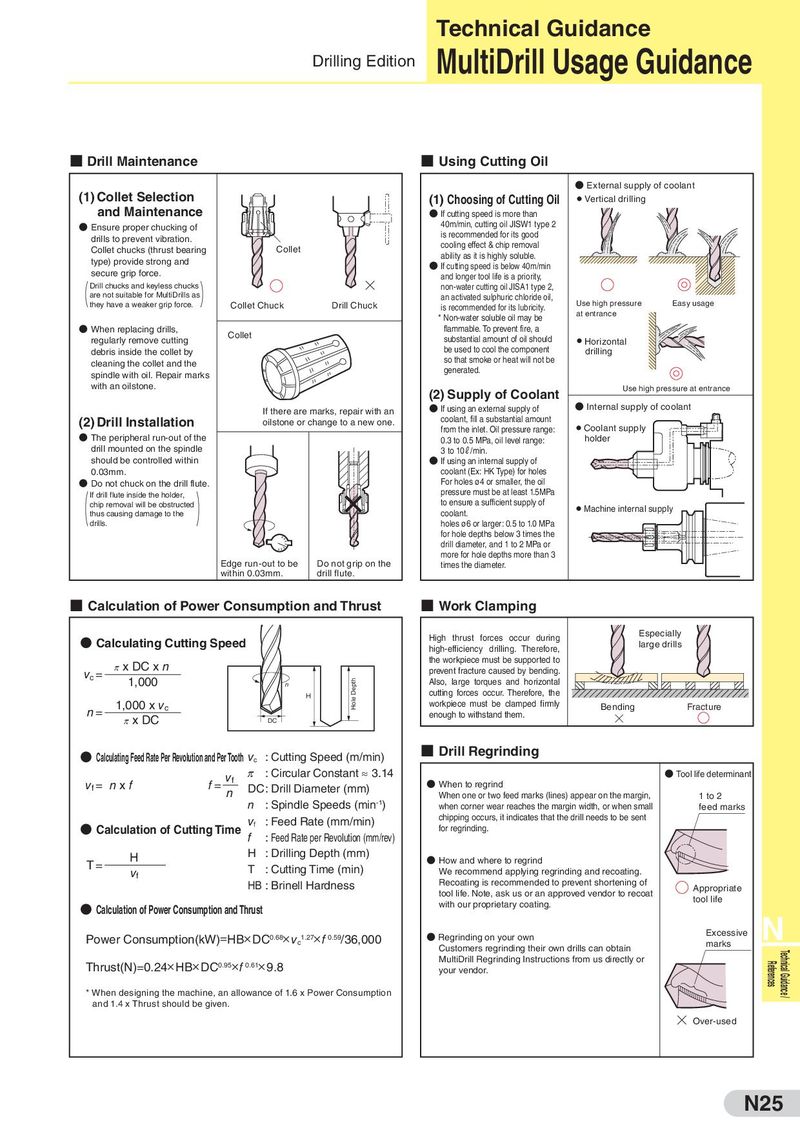Техническая информация Sumitomo - страница 17
Навигация
 Каталог Sumitomo пластины с алмазными вставками Sumidia
Каталог Sumitomo пластины с алмазными вставками Sumidia Общий каталог Sumitomo 2019 - 2020
Общий каталог Sumitomo 2019 - 2020 Каталог Sumitomo токарные резцы (державки) для наружного точения
Каталог Sumitomo токарные резцы (державки) для наружного точения Каталог Sumitomo твердосплавные пластины
Каталог Sumitomo твердосплавные пластины Каталог Sumitomo фрезы со сменными пластинами
Каталог Sumitomo фрезы со сменными пластинами Каталог Sumitomo пластины с режущей кромкой-моноалмаз Sumicristal
Каталог Sumitomo пластины с режущей кромкой-моноалмаз Sumicristal 
Technical Guidance Drilling Edition MultiDrill Usage Guidance ■ Drill Maintenance ■ Using Cutting Oil ● External supply of coolant (1) Collet Selection (1) Choosing of Cutting Oil ● Vertical drilling and Maintenance ● If cutting speed is more than ● Ensure proper chucking of 40m/min, cutting oil JISW1 type 2 drills to prevent vibration. is recommended for its good Collet chucks (thrust bearing Collet cooling effect & chip removal type) provide strong and ability as it is highly soluble. secure grip force. ● If cutting speed is below 40m/min and longer tool life is a priority, ( ) Drill chucks and keyless chucks non-water cutting oil JISA1 type 2, are not suitable for MultiDrills as an activated sulphuric chloride oil, they have a weaker grip force. Collet Chuck Drill Chuck is recommended for its lubricity. Use high pressure Easy usage * Non-water soluble oil may be at entrance ● When replacing drills, Collet flammable. To prevent fire, a regularly remove cutting substantial amount of oil should ● Horizontal debris inside the collet by be used to cool the component drilling cleaning the collet and the so that smoke or heat will not be spindle with oil. Repair marks generated. with an oilstone. (2) Supply of Coolant Use high pressure at entrance If there are marks, repair with an ● If using an external supply of ● Internal supply of coolant (2) Drill Installation oilstone or change to a new one. coolant, fill a substantial amount from the inlet. Oil pressure range: ● Coolant supply ● The peripheral run-out of the 0.3 to 0.5 MPa, oil level range: holder drill mounted on the spindle 3 to 10L/min. should be controlled within ● If using an internal supply of 0.03mm. coolant (Ex: HK Type) for holes ● Do not chuck on the drill flute. For holes ø4 or smaller, the oil ( ) If drill flute inside the holder, pressure must be at least 1.5MPa chip removal will be obstructed to ensure a sufficient supply of ● Machine internal supply thus causing damage to the coolant. drills. holes ø6 or larger: 0.5 to 1.0 MPa for hole depths below 3 times the drill diameter, and 1 to 2 MPa or more for hole depths more than 3 Edge run-out to be Do not grip on the times the diameter. within 0.03mm. drill flute. ■ Calculation of Power Consumption and Thrust ■ Work Clamping High thrust forces occur during Especially ● Calculating Cutting Speed high-efficiency drilling. Therefore, large drills π x DC x n the workpiece must be supported to vc = prevent fracture caused by bending. 1,000 n Hole Depth Also, large torques and horizontal H cutting forces occur. Therefore, the n= 1,000 x vc workpiece must be clamped firmly Bending Fracture π x DC DC enough to withstand them. ● Calculating Feed Rate Per Revolution and PerTooth vc : Cutting Speed (m/min) ■ Drill Regrinding vf π : Circular Constant ≈ 3.14 ● Tool life determinant vf = nxf f= n DC : Drill Diameter (mm) ● When to regrind When one or two feed marks (lines) appear on the margin, 1 to 2 n : Spindle Speeds (min-1) when corner wear reaches the margin width, or when small feed marks vf : Feed Rate (mm/min) chipping occurs, it indicates that the drill needs to be sent ● Calculation of Cutting Time for regrinding. f : Feed Rate per Revolution (mm/rev) H H : Drilling Depth (mm) ● How and where to regrind T= vf T : Cutting Time (min) We recommend applying regrinding and recoating. HB : Brinell Hardness Recoating is recommended to prevent shortening of Appropriate tool life. Note, ask us or an approved vendor to recoat tool life ● Calculation of Power Consumption and Thrust with our proprietary coating. Power Consumption(kW)=HB× DC0.68× vc1.27× f 0.59/36,000 ● Regrinding on your own Excessive N Customers regrinding their own drills can obtain marks Thrust(N)=0.24× HB× DC0.95× f × 0.61 9.8 MultiDrill Regrinding Instructions from us directly or References Technical Guidance / your vendor. * When designing the machine, an allowance of 1.6 x Power Consumption and 1.4 x Thrust should be given. Over-used N25